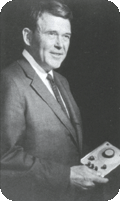Evolution of the Bill Hewlett's 200A Audio Oscillator
By the beginning of the 1960s Bill Hewlett's original RC Oscillator had already found many usages in various kinds of electronic instruments. In the 1960 general catalog, the most visible part of this evolution is illustrated by the 200 series oscillators. Each of these oscillators uses the basic resistance tuned oscillator invented by Bill Hewlett in 1938. The main differences between the various modeles stood in the covered frequency range, and in the output power and impedance. The resulting product line, thus gave answers to different market needs.


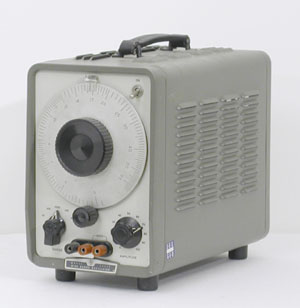 |
HP 200CD
|
The HP 200CD
Among the above listed 200 series oscillators, the largest diffused one was the 200CD.
The HP 200CD has the following specifications: Frequency coverage 5 cps to 600 Kc in 5 ranges. 160 mW into 600 ohms or 20 Volts open circuit at 1 % distortion and +/- 1 dB frequency response.
The HP200CD remained in the Hewlett-Packard Test and Measurement catalog until 1985, a full 33 years which is rare in the electronics industry. The 200CD was the last fully vacuum-tube instrument produced by HP. The 428B Clip-on DC Milliammeter remained one more year in the catalog but for the purist, the 428B included some transistors in its latest versions.
Animation Display: Interior Panoramic View of the HP 200CD
Animation |
 |
|
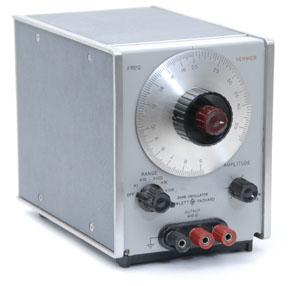 |
The HP 204B Audio Oscillator
|
The HP 204B, First Full Transistor
Audio Oscillator
Introduced in the 1961 catalog, the 204B was the very first fully transistorized and battery-operated HP audio oscillator.
In the beginning of the sixties, the main and most visible advantage of transistors over vacuum tubes was frequently brought to the foreground in publicity for a new instrument. The description of the 204B didn't escape this rule, claiming that the instrument's internal heat production was small, resulting in unusually low warmup drift, and that stable and accurate signals were instantly available at the output.
The 204B frequency range goes from 5 cps to 500 kc in 5 bands with a dial accuracy of 3%. Maximum output level is 10 milliwatts into 600 Ohms, and a continuously variable bridged "T" attenuator permits an output level control over at least 40 dB range. The 204B output is fully floating, isolated from power line ground and instrument chassis. The output frequency response is specified to +/- 3 % with a distortion less than 1 %. Introduction price for the HP 204B was $275.00 USD.
Last but not least, the 204B was the first to use a new modular cabinet design. This new modular design would eventually become the mechanical standard for every small and medium sized instrument produced during the full following decade and more. Up to 1975, HP's first enclosure system was reffered to, inside the company, as "System I" enclosure. It was a notable improvement to the earlier approach. By making it convenient either to mount instruments in racks or stack them neatly for bench use, it solved many of the problems of grouping increasing numbers of instruments in complex measurement setups. Access to the internal parts was also made easier, and the space put to more efficient use. It was an entirely new concept in instrument packaging. It served HP's customers well, and was copied many times over by other manufacturers.
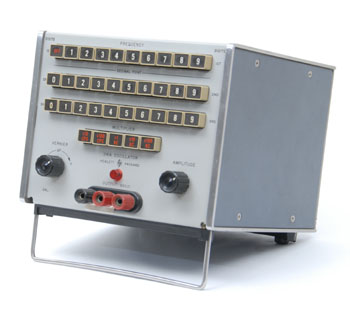 |
HP 241A
|
The HP 241A
Push-Button Oscillator
Yes, it looks like a syntheziser, but it isn't yet, it's just an analog oscillator with push-button frequency selection.
Introduced in the 1963 catalog, the 241A's main objective was to bring the push-button convenience and repeatability for selecting frequencies from 10 cps to 999 kc to the laboratory or production work . The simple depression of three frequency buttons and one of five decade multipliers selects any of the 4500 possible discrete frequencies.
The basic circuit arrangement of the oscillator uses Wien Bridge with amplitude stabilization of amplifier output by a peak detector returned to amplifier input. (See diagram below)
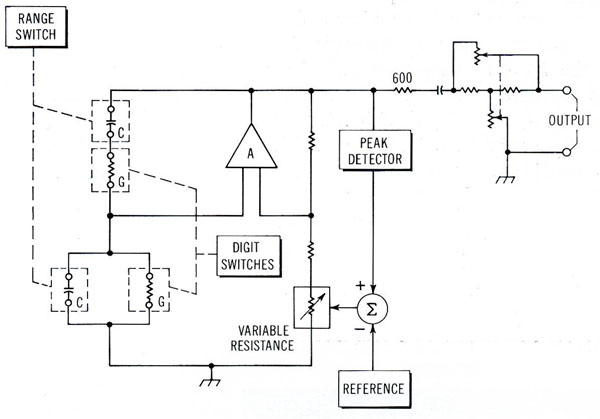 |
HP 241A Simplified Circuit Diagram - From the August 1963 issue of the Hewlett Packard Journal
Courtesy of Hewlett-Packard Company |
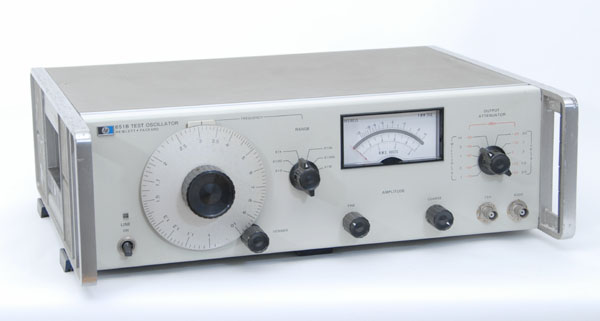 |
| HP 651B - Test Oscillator |
 |
From Top to Bottom - HP 654A - HP 652A - HP 651B
|
The HP 650 Series
Test Oscillators
In 1965, the HP 651A, first of a new generation of test oscillators took over the "good old," all vacuum tube, HP 650A born in 1948.
Every oscillator of the 650 series use a Wien Bridge basic circuit arrangement followed by a negative feedback amplifier and associated output attenuator and precision output amplitude metering circuit. The picture below shows the block diagram common to every test oscillator of the HP 650 series.
Every oscillator of the 650 series covered a frequency range of 10 Hz to 10 MHz in 6 bands, and like for the 200 series the main characteristics differencing the various modeles stood in the output amplifiers and attenuators to offer a large choice of impedance and voltage level, and to cover a wide range of applications.
 |
HP 651A Simplified Circuit Diagram - From the June 1965 issue of the Hewlett Packard Journal
Courtesy of Hewlett-Packard Company |
Animation Display: Interior Panoramic View of the HP 651B
Animation |
 |
|
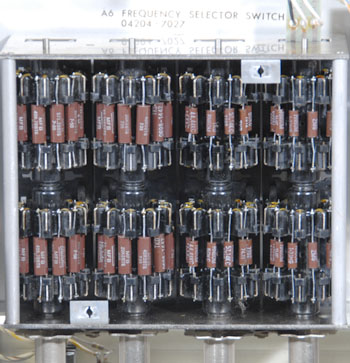 |
The HP 4204A Digital Tunning Turrets
|
The HP 4204A Digital Oscillator
The 4204A was introduced in the 1967 catalog and named "Digital Oscillator." But the 4204A didn't contain any digital electronic circuits. The name came from its mechanical digital frequency selector switch shown in the picture on the left.
Any frequencies between 10.0 Hz and 999.9 kHz can be "digitally" selected with an in-line rotary switch, to four significant figures. As many as 36,900 discrete frequencies are available, and infinite resolution is provided by one vernier control. Frequency accuracy was specified to better than +/- 0.2 % and repeatability to better than +/- 0.01 %.
The 4204A's maximum output is 10 Volts, or 22 dBm into a 600 Ohms matched load. The output attenuator has an 80 dB range, adjustable in 10 dB steps with a 20 dB vernier.
The 4204A was one of the very few instrument, out of the component-test product line, developed and manufactured by the Yokogawa Hewlett Packard Japanese Factory.
 |
| HP 4204A Digital Oscillator |
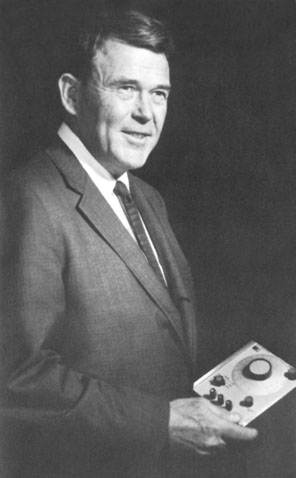 |
Bill Hewlett holding a 204C Oscillator
Back cover of MEASURE Magazine, February 1968
Courtesy of Hewlett-Packard Company
|
1968, Thirty Years and...
...250,000 Oscillators Later...
The HP 204C's introduction in 1968 was an opportunity to celebrate the success and the longevity of Bill Hewlett's original big idea. In 1968, more than 250,000 oscillators using Bill's invention were already produced, and the last evolution, the HP 204C was unveiled in the HP Loveland factory, as announced in the February issue of MEASURE Magazine:
"A 29-year slice of HP history was spanned recently when a new, solid-state version of the company's first instrument, the 200A oscillator, was introduced. And it was only appropriate that President Bill Hewlett, inventor of the original instrument, should be in Loveland for the unveiling of the 204C. The new instrument is smaller, lighter, and much improved in performance, but the operating principles are exactly the same as the classic 1939 invention. The oscillator surely ranks as one of the company's all-time "big ideas." "
In 1968, according to the editorial advisory board of Industrial Research magazine, the HP 204C was listed among the 100 most significant new technical products developed by industry. The board's selections included two other HP products among the first 100: The 9100A desk-top calculator, and the HPA's strip-line PIN diode.
 |
HP 204C
|
...The HP 204C Oscillator
The 204C is described in the December 1968 issue of the Hewlett Packard Journal as a Low-Cost, General-Purpose Oscillator with Low Distortion and High Stability.
Output of the HP Model 204C is a sine wave from 5 Hz to 1 .2 MHz in six overlapping bands. The amplitude is 5 V rms open circuit with a 600 ohm output impedance. The instrument can be line or battery operated. It can be powered from either mercury cells, or from rechargeable nickel-cadmium batteries. One of the main advantages of the Model 204C is high signal purity. Total harmonic distortion approaches 70 dB below fundamental across most of the frequency range.
 |
The HP 239A - Low Distortion Oscillator
|
The HP 239A
Low Distortion Oscillator
The 239A low distortion oscillator appeared in the 1979 catalog. It would be the very last, fully analog signal source produced by HP. The 239A Oscillator is electricaly similar to the built-in oscillator used in the HP 339A distortion measurement set.
The 239A covers from 10 Hz to 110 kHz in 4 overlapping decade ranges with 2 digit resolution. The output level is variable from 1 millivolt to 3.16 Vrms into 600 ohms.
The unequalled characteristic of the HP 239A is its distortion specification. For a 3 volts output, up to 20 kHz, the signal distortion is below -95 dB, which is equivalent to a 0.0018 %THD ! In the upper part of its frequency coverage, up to 110 kHz the distortion stay specified below -70 dB (0.032% THD) These unsurpassed characteristics make the HP 239A, a still today highly appreciated reference for distortion measurement on the audiophile test bench.
Twenty years of transistor circuitry evolution resulted in the signal spectral purity improvement clearly visible below. A 1961, HP 204B output signal is measured in the left hand picture, and a 1979, HP 239A output on the right. Both sources are tuned to 10 kHz with output levels set at 1 milliwatt into a 600 ohms load at the 1 Megohm input of a 3585A Spectrum Analyzer.
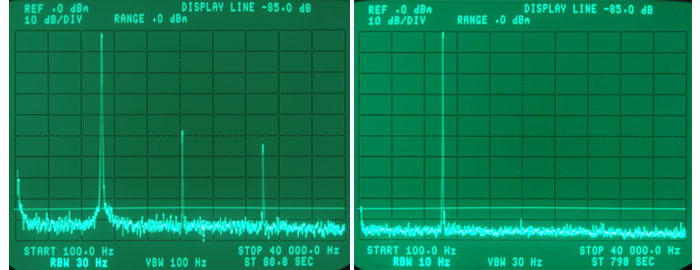 |
Distortion of a 10 kHz Signal from the collection HP 204B on the left and from the HP 239A on the right
Both Displayed on a 3585A Spectrum Analyzer |


